Woulda, coulda, shoulda. That was the story of Gram’s life. He’d have turned 70 today, and might have accomplished a whole lot of things had he not checked out (chemically, permanently) in room #8 of the Joshua Tree Inn on September 19, 1973.
I’ve written a lot about the man and his music through the years. Now, just how many more new aspects of Gram can I force feed you?
Let’s take a look at some of his few existing filmed performances, starting with an all-too-short appearance in “The Trip,” a 1967 counter-culture movie directed by Roger Corman. It includes several scenes that feature Gram performing with one of his early groups, The International Submarine Band. It’s hard to catch Gram in action in this clip, because the scenes are short and the editing is fast. But you can see him in the early scene wearing a striped shirt, standing in the middle of the other band members, way in the background. In the party scene he’s wearing a red jacket, high-neck white shirt and sunglasses. He always stands out in a crowd.
Gram wrote the song “Lazy Days” for this film, but Corman felt it wasn’t psychedelic enough for this acid hippie flick. So he kept the scenes of the band lip-syncing and guitar-syncing and replaced the music with a track by the band Electric Flag (listed in credits as The American Music Band). There’s no credit in the film for Gram or the Sub Band. The movie stars Peter Fonda and Bruce Dern and was written by Jack Nicholson.
Gram gets some real face-time at last, flirting and flaunting for the camera in this 1969 video with The Flying Burrito Brothers, the group he co-founded with Chris Hillman in 1968. “Christine’s Tune” is one of the group’s best and most popular songs. He co-wrote it with Hillman (who shares lead vocals) about Christine Hinton, a one-time girlfriend of David Crosby’s. When Christine was killed in a freak car accident shortly after this song was recorded it became known as “Devil in Disguise.” The boys were all decked out in their famous “Nudie Suits” for this performance. But look closely at Gram’s ensemble, embellished with flames, poppies, multi-colored pills, marijuana leaves, crucifixes, and nude women. Of all the outfits designed by Nudie Cohn’s Rodeo Tailors, Gram’s costume is considered the most spectacular of all.
Finally, by 1970, Gram is ready for his close-up, hamming it up as a swinging yachtsman in this video for the Burritos’ “Older Guys.” He had been hanging out with the Rolling Stones quite a bit during this period of his career, forging a drug-fueled, brother-like relationship with Keith Richards. But clearly it was Mick he was shamelessly copying in this video: hands on his skinny hips, scarf around his neck, strutting around with barely a trace of undies beneath his little white pants. Legend has it that some of Gram’s Burrito Brothers hated the way he shimmied and strolled in this performance.
Had Gram lived, would he have wanted to try his hand at acting, as many of contemporaries did at one time or another? Mick Jagger, Roger Daltrey, David Bowie, Tom Waits, and Bob Dylan all took their turns on the big screen. Well, we’ll never know. But one thing’s for sure: his topsy-turvy life and bizarre desert DIY post-mortem would make for one damn compelling “truth is stranger than fiction” film.
Here’s “Lazy Days,” the rejected song Gram wrote for “The Trip.” It later appeared on the Flying Burrito Brothers’ “Burrito Deluxe” LP.
© Dana Spiardi, Nov 5, 2014
Click here to help induct Gram in to the Country Music Hall of Fame.
]]>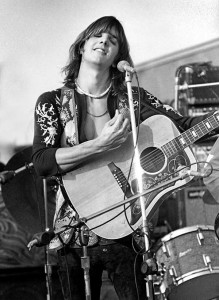 Gram’s early life was full of all the sordid ingredients that make for a classic southern gothic melodrama. Born into a filthy rich family on November 5, 1946, Ingram Cecil Connor III would lose both parents while still a teen. When Gram was 12 his alcoholic father committed suicide at the family home in Waycross, Georgia. Soon after, his mother – heiress to a Florida citrus empire – married a philanderer named Robert Parsons, who adopted Gram and his younger sister Avis. On the day Gram graduated from high school his alcoholic mother died from cirrhosis of the liver. Bob Parsons wound up marrying the household babysitter and putting young Avis in a mental institution. Gram ended up with a large trust fund that would sustain him financially for the rest of his life. He headed to Harvard, dropped out after one semester, and soon hooked up with musicians who helped crystallize his musical ambitions.
Gram’s early life was full of all the sordid ingredients that make for a classic southern gothic melodrama. Born into a filthy rich family on November 5, 1946, Ingram Cecil Connor III would lose both parents while still a teen. When Gram was 12 his alcoholic father committed suicide at the family home in Waycross, Georgia. Soon after, his mother – heiress to a Florida citrus empire – married a philanderer named Robert Parsons, who adopted Gram and his younger sister Avis. On the day Gram graduated from high school his alcoholic mother died from cirrhosis of the liver. Bob Parsons wound up marrying the household babysitter and putting young Avis in a mental institution. Gram ended up with a large trust fund that would sustain him financially for the rest of his life. He headed to Harvard, dropped out after one semester, and soon hooked up with musicians who helped crystallize his musical ambitions.
This early history is crucial, because it sheds light on how and why Gram turned out the way he did – and how he ended up writing some of the most heartbreaking songs in history. But I’ll stop here with the biographical details. There is plenty of juicy Gram lore on the Internet. All of his major personal and professional highs and lows are well documented: his hasty flight from the Byrds on the eve of a tour of apartheid South Africa; his high-output days with Chris Hillman in the early Flying Burrito Brothers; his exchange of musical knowledge, pharmaceuticals and heroin cures with brother-figure Keith Richards; his often erratic drug- and alcohol-fueled performances; his brilliant collaborations with Emmylou; his sad death from morphine and booze in Room 8 of the low-rent Joshua Tree Inn just as his solo career was taking off.
And then there’s the grandaddy of all Gram legends: the kidnapping and DIY cremation of his body in Joshua Tree National Park by his inebriated, ex-con road manager Phil Kaufman – a tale so twisted it became the basis for the moronic movie Grand Theft Parsons. This stunt, coupled with the poor-little-rich-boy saga of his early years and the high-lonesome style of his life and music, have elevated Gram Parsons to mythic status.
Like so many others who died young from misadventure, Gram has been analyzed, scrutinized and lionized by countless music historians. He’s described by all who knew him as winsome, magnetic, well-mannered, passionate, generous, visionary, even “cuddly” (yes, fellow Burrito Chris Hillman said that). One of my favorite quotes is from the superb music writer Stanley Booth, who said, “Gram was in his way a pure soul, pure and driven as the driven snow. When I met him, he looked like a green-eyed Palomino pony.”
Yet, he’s described by many of the same people as irresponsible, flighty, self-centered, spoiled, attention-hungry, musically careless, even fatalistic – destined to follow the path of his self-destructive parents. Manuel Cuevas, the Nudie’s Rodeo Costumes tailor who created some of the world’s most spectacular stage wear, speculates that Gram was predicting his manner of death when he asked him to embroider flames, poppies, multi-colored pills, marijuana leaves, a crucifix and nude women onto the famous suit he was so often photographed wearing.
In the end, what’s most important is Gram Parsons’ contributions to the world of music. One of things that most impresses me was his unflinching devotion to turning the world on to the beauty and honesty of the country sound and its natural role in what he referred to as Cosmic American Music. Tales of Gram jumping onto his motorcycle to race off and buy George Jones and Merle Haggard records to play for his country-illiterate friends are legendary.
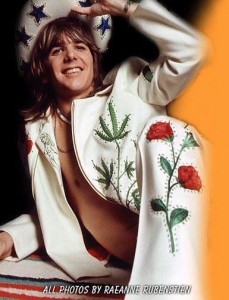 Promoting and performing country music the way he did during the height of the psychedelic, protest-era 1960s was a gutsy thing to do. His efforts offended many country purists and turned off just as many rock fans. Singing onstage in hardcore cowboy clubs wearing flamboyant, sometimes effeminate, country-western clothing took a lot of confidence (and he had it in spades). Many argue that Gram didn’t invent country rock (a genre term he hated, by the way). Others were injecting twang into modern music years before he came along. But it was this groovy, gorgeous, long-haired Harvard dropout who made country COOL. By the mid-1970s there would be a glut of soulless country rock acts. The music became mainstream, boring, and just plain commercial.
Promoting and performing country music the way he did during the height of the psychedelic, protest-era 1960s was a gutsy thing to do. His efforts offended many country purists and turned off just as many rock fans. Singing onstage in hardcore cowboy clubs wearing flamboyant, sometimes effeminate, country-western clothing took a lot of confidence (and he had it in spades). Many argue that Gram didn’t invent country rock (a genre term he hated, by the way). Others were injecting twang into modern music years before he came along. But it was this groovy, gorgeous, long-haired Harvard dropout who made country COOL. By the mid-1970s there would be a glut of soulless country rock acts. The music became mainstream, boring, and just plain commercial.
If you’re a Gram devotee, you dig what I’m saying. If you’re new to all this, go to the Internet and sample his songs. Watch some of the few available videos of his performances on YouTube. Check out his early work with the International Submarine Band, the Byrds and the Flying Burrito Brothers. Pay close attention to two of his masterpieces: “Hickory Wind” and “Hot Burrito #1.” And don’t overlook his final solo albums – “GP” and “Grievous Angel” – which feature his brilliant harmonies with the ethereal Emmylou Harris, who today is Gram’s biggest champion.
Some of these sounds will make you swing and some will make you sad. But that’s okay. Who doesn’t love a deliciously melancholy tears-in-your-beer heartache song? When I hear Gram, with his alcohol-marred, high-lonesome voice harmonizing with Emmylou on the gorgeous “A Song For You,” I can literally sense his demise. This is an audio snapshot of an artist stripped bare for all the world to see. Rest in peace, Gram Parsons. You saw your devil…and you saw your deep blue sea.
Here’s Gram and Emmylou, singing “Return of the Grievous Angel.” The great James Burton, who played with Elvis from 1969 to 1977, provided guitar on this track. “Pick it for me, James!”
And here’s the gorgeous “Hickory Wind,” which Gram wrote and performed during his short time as a member of The Byrds. When the band played the Grand Ole Opry in March 1968, Gram shocked the audience by playing this song instead of the one he was slated to perform, Merle Haggard’s “Life in Prison.” The Opry and its fans felt that Gram violated the venue’s policy of performing only pure country music.
Click here to help induct Gram in to the Country Music Hall of Fame.
Click here to learn about Hickory Wind Ranch Recovery Center, founded by Gram’s daughter, Polly Parsons.
Photo of Gram in the cowboy “Nudie Suit” is by Raeanne Rubenstein.
© Dana Spiardi, Sept 19, 2013
]]>Buck Owens was a pioneer of the “Bakersfield sound,” an upbeat, stripped-down honky-tonk style of music that mixed old-time country swing with electric guitars and a rocking backbeat. Bakersfield music stood as a type of revolt against the Nashville sound, with its slick, sweet orchestrations and polished production values. Buck enjoyed a 50-year career as a singer, songwriter and musician. He and his band The Buckaroos placed 21 No. 1 hits on the Billboard country music charts. Yet, he never really followed a strict country formula for success.
 Soon after the British Rock Invasion of 1964, Buck started buying Beatles albums and performing “Twist and Shout” using the Beatles’ arrangement of the old Isley Brothers hit. He and his band members even donned Beatle wigs when they performed the song at Carnegie Music Hall for a live album recording in 1966! All the while, The Beatles were requesting four copies of all of Buck’s albums through their mutual record label, Capitol. The Beatles, like many British rockers of that era, loved country music. Their mid-’60s compositions – “I’ll Cry Instead,” “I’ve Just Seen a Face” and “What Goes On” – are among the earliest examples of country-inspired rock songs.
Soon after the British Rock Invasion of 1964, Buck started buying Beatles albums and performing “Twist and Shout” using the Beatles’ arrangement of the old Isley Brothers hit. He and his band members even donned Beatle wigs when they performed the song at Carnegie Music Hall for a live album recording in 1966! All the while, The Beatles were requesting four copies of all of Buck’s albums through their mutual record label, Capitol. The Beatles, like many British rockers of that era, loved country music. Their mid-’60s compositions – “I’ll Cry Instead,” “I’ve Just Seen a Face” and “What Goes On” – are among the earliest examples of country-inspired rock songs.
Eventually, Buck’s penchant for performing pop-rock songs began to elicit criticism from his hard-core country fans. He felt compelled to purchased a full-page ad in the March 1965 issue of the Nashville-based fan magazine Music City News to announce his “Pledge to Country Music:”
I shall sing no song that is not A country song. I shall make no record that is not a country record. I refuse to be known as anything but a country singer. I am proud to be associated with country music. Country music and country music fans made me what I am today. And I shall not forget it.
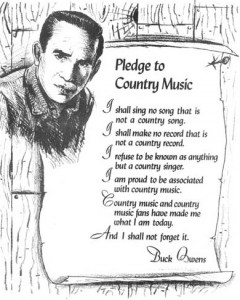 What’s up with that, Buck? Bowing to pressure from purists? When he included Chuck Berry’s “Memphis” on his 1965 LP “I’ve Got a Tiger by the Tail,” he was accused of reneging on his promise. His response: “I see ‘Memphis’ as bein’ rockabilly. I didn’t say I wasn’t gonna do rockabilly. I just said I ain’t gonna sing no song that ain’t a country song. I won’t be known as anything but a country singer. I meant that, I still mean that. Listen to the lyrics. If they’re not country lyrics…the melody…if that ain’t a country melody…The only thing was, a black man was singin’ it, a black man who I was a big fan of.”
What’s up with that, Buck? Bowing to pressure from purists? When he included Chuck Berry’s “Memphis” on his 1965 LP “I’ve Got a Tiger by the Tail,” he was accused of reneging on his promise. His response: “I see ‘Memphis’ as bein’ rockabilly. I didn’t say I wasn’t gonna do rockabilly. I just said I ain’t gonna sing no song that ain’t a country song. I won’t be known as anything but a country singer. I meant that, I still mean that. Listen to the lyrics. If they’re not country lyrics…the melody…if that ain’t a country melody…The only thing was, a black man was singin’ it, a black man who I was a big fan of.”
Well, I’ll overlook him. Those were different times. Besides, he remained a maverick in many respects as the decade advanced. In 1967, he and The Buckaroos suited up in sparkling outfits to play the Fillmore West, a San Francisco hippie venue known for hosting rock bands, not country acts. The band’s dueling Telecaster licks wowed the crowd. Performances like these were a huge influence on a young Gram Parsons, who helped to pioneer country rock during his short life.
That same year, Buck and the boys became one of the first country bands to tour Japan. The resulting album, “Buck Owens and His Buckaroos in Japan,” was perhaps the first country album recorded outside of the United Sates.
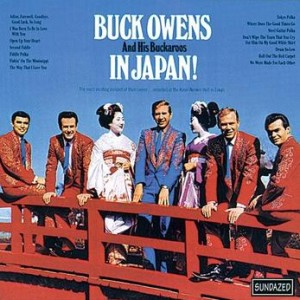
Buck went on to perform at venues not usually frequented by country performers: Madison Square Garden, the London Palladium and the Royal Albert Hall. Interestingly, he never played the Grand Ole Opry in his heyday (save for one brief appearance, when he played guitar for Tommy Collins in 1954). He was a Bakersfield boy, not a Nashville cat. I believe the Rolling Stones were paying homage to Buck in their honky 1978 song “Far Away Eyes,” when Mick sings, I was driving home early Sunday morning, through Bakersfield… The song’s title may even have sprung from these Buck Owens lyrics: I can see that far-away look in your eyes.
Thanks to that ol’ Wurlitzer in my grandparents’ tavern, I knew about Buck even before I heard The Beatles’ version of “Act Naturally.” His 1964 single “I’ve Got a Tiger by the Tail,” with its B side “Crying Time,” was popular among our bar’s coalminer clientele. Those songs were favorites of mine, as well, right alongside all The Beatles tunes. Buck’s records introduced me to country music. As a kid, I loved the western swing of “Tiger,” but it was “Crying Time” that’s long struck my melancholy chord. Mood-spinners like me always know when it’s crying time again.
Happy 86th birthday, Buck, and thanks for always acting naturally.
Here’s Buck and His Buckaroos performing “I’ve Got a Tiger by the Tail” in 1966. Oh, the gorgeous, glittering suits! I think it’s pretty durn cute the way Buck grins while he’s singing this song.
Oh, “Crying Time”! What fabulous lyrics. White man’s blues. Even though Buck wrote this song and recorded it in 1964, it was Ray Charles’ 1966 version that became the bigger hit.
© Dana Spiardi, August 12, 2015
]]>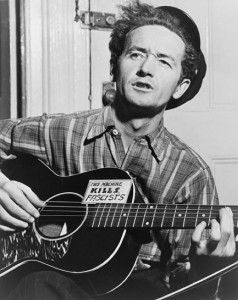 In 1945 Woody Guthrie married his second wife, Marjorie Greenblatt Mazia, who had been a dancer with the Martha Graham Dance Company in New York. The two met when a choreographer from the troupe developed a dance based on one of Woody’s many whimsical protest songs. Marjorie’s mother just happened to be Aliza Greenblatt, a well-known Yiddish poet. She lived across the street from Woody and Marjorie on Mermaid Avenue in Brooklyn’s Coney Island. Woody and his mother-in-law, known to all as Bubbie, enjoyed a close, collaborative relationship. They shared similar interests – anti-fascism, pro-labor activism, folk lore – and a desire to promote social justice through music and art. Aliza played a large role in the Guthrie household, babysitting the kids and serving Friday night Sabbath dinners. She inspired Woody’s deep appreciation for Jewish history and culture. He likened the struggles of the Jews to those of his fellow Okies and other oppressed people.
In 1945 Woody Guthrie married his second wife, Marjorie Greenblatt Mazia, who had been a dancer with the Martha Graham Dance Company in New York. The two met when a choreographer from the troupe developed a dance based on one of Woody’s many whimsical protest songs. Marjorie’s mother just happened to be Aliza Greenblatt, a well-known Yiddish poet. She lived across the street from Woody and Marjorie on Mermaid Avenue in Brooklyn’s Coney Island. Woody and his mother-in-law, known to all as Bubbie, enjoyed a close, collaborative relationship. They shared similar interests – anti-fascism, pro-labor activism, folk lore – and a desire to promote social justice through music and art. Aliza played a large role in the Guthrie household, babysitting the kids and serving Friday night Sabbath dinners. She inspired Woody’s deep appreciation for Jewish history and culture. He likened the struggles of the Jews to those of his fellow Okies and other oppressed people.
More than thirty years after Woody’s death, his daughter Nora began to dig through The Woody Guthrie Archives, resurrecting the Jewish-themed lyrical poems he had written in 1940s and 50s. These include poems such as “Honeyky Hanukah Time,” written in typically playful Woody style:
It’s Honeyky Hanukah, shaky my hand,
My candles are burning all over this land,
To light the dark road for the man passing by,
It’s Honeyky Hanukah time.
It’s Honeyky Hanukah, kissy my cheek,
The light in my window it burns for a week,
I’ll open my present and take a little peek,
It’s Honeyky Hanukah time.
Nora decided to have Woody’s words set to music, and asked The Klezmatics, an eclectic klezmer band, to carry out the project. The resulting songs were the highlight of a 2003 concert, ”Holy Ground: The Jewish Songs of Woody Guthrie,” staged on the first night of Hanukkah at the legendary 92nd Street Y in New York. In 2010, The Klezmatics released the songs on their album “Wonder Wheel,” which the Grammy Award for Best Contemporary World Music Album at the 49th Grammy awards.
 Nora wants to make sure that these songs cast her father in a much broader light. She once told an interviewer, “He was a poet and lyricist who wrote about everything. I don’t want to see him turned into a freeze-dried, Dust Bowl icon representing a narrow version of what somebody thinks he was. These songs are just one more facet of his work that will add to a fuller picture of him as a songwriter.”
Nora wants to make sure that these songs cast her father in a much broader light. She once told an interviewer, “He was a poet and lyricist who wrote about everything. I don’t want to see him turned into a freeze-dried, Dust Bowl icon representing a narrow version of what somebody thinks he was. These songs are just one more facet of his work that will add to a fuller picture of him as a songwriter.”
If I had it my way, every grade school child in America would be required to spend an entire week immersed in the life and times of Woodrow Wilson Guthrie. He was one of America’s purest souls and most accomplished folk heroes — an artist, activist, diarist, humorist, humanitarian, and rabble-rouser. If you’re a lover of music, if you believe that music has the power to incite, to inspire, and to change the world, please remember Woody today on his 103rd birthday.
Here are some delightful lyrics from another of Woody’s Jewish-themed poems, “Mermaid Avenue:”
Mermaid Avenue that’s the street
Where the lox and bagles meet,
Where the hot dog meets the mustard
Where the sour meets the sweet;
Where the beer flows to the ocean
(Where the halvah meets the pickle)
Where the wine runs to the sea;
Why they call it Mermaid Avenue
That’s more than I can see.
Please watch this beautiful video of my favorite Woody song, “So Long, It’s Been To Know You,” from the Library of Congress recording:
© Dana Spiardi, July 14, 2015
]]>
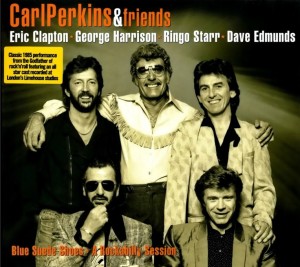 Since its release in January 1956, there’s never been a shortage of blue suede in the world of rock. The song has been covered by everyone from The Beatles and Buddy Holly to Bill Haley and Pat Boone. But I’ll bet you didn’t know that some rather unlikely artists have also recorded and performed this most sacred of rock tunes. Here’s a smathering of some rather outré Blue Suede renditions, plus covers of other Perkins classics.
Since its release in January 1956, there’s never been a shortage of blue suede in the world of rock. The song has been covered by everyone from The Beatles and Buddy Holly to Bill Haley and Pat Boone. But I’ll bet you didn’t know that some rather unlikely artists have also recorded and performed this most sacred of rock tunes. Here’s a smathering of some rather outré Blue Suede renditions, plus covers of other Perkins classics.
Avant-garde musicians The Residents:
Swedish Elvis impersonator Eilert Pilarm:
Here’s Filipina recording artist Regine Velasquez with a bluesy, sexy version. I think she actually wants her man to make love to her shoes.
Guitar god Jimi Hendrix performed this very funky rendition of Carl’s song. And you just KNOW that Jimi had blue psychedelic shoes of some sort.
And then there’s bad boy Lemmy:
“Blue Suede Shoes” isn’t the only Perkins song beloved by rockers of all stripes. Punk band The Cramps covered Carl’s “Her Love Rubbed Off” on their album “Stay Sick.”
The Beatles recorded three Perkins-penned songs on their studio albums: “Matchbox,” “Everybody’s Trying to be My Baby,” and “Honey Don’t.”
In fact, “Honey Don’t” is the only officially released Beatles song that was covered by each member individually: John recorded it for the soundtrack of his homemade film Clock; Paul recorded it with Perkins during sessions for Paul’s “Tug Of War” album; Ringo performed it with Carl for the 1986 TV special Blue Suede Shoes: A Rockabilly Session With Carl Perkins And Friends; and George performed a version with Bob Dylan and John Fogerty at a 1987 Hollywood gig by bluesman Taj Mahal.
Paul once said, “If there were no Carl Perkins, there would be no Beatles.” Here’s George singing “Everybody’s Trying to be My Baby.”
Carl Perkins died at age 65 on January 19, 1998, from throat cancer. Here’s a clip of that cool cat singing one of my favorites, “Matchbox.”
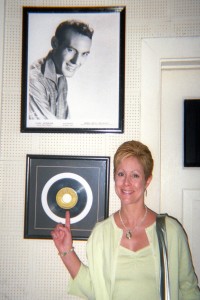 I had the privilege of visiting Sun Studios in Memphis a few years back, and got to stand in the room where Carl, Elvis, Johnny Cash, and Jerry Lee Lewis once made history. Here I am, pointing to Carl’s original 45 of “Blue Suede Shoes,” with his portrait above it. I was “Gone, Gone, Gone,” baby.
I had the privilege of visiting Sun Studios in Memphis a few years back, and got to stand in the room where Carl, Elvis, Johnny Cash, and Jerry Lee Lewis once made history. Here I am, pointing to Carl’s original 45 of “Blue Suede Shoes,” with his portrait above it. I was “Gone, Gone, Gone,” baby.
© Dana Spiardi, January 19, 2015
]]>